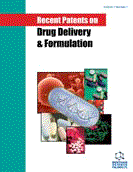Abstract
Background: Chitosan, a naturally occurring polymer, has interesting applications in the field of drug delivery due to its plentiful advantages as biodegradability, biocompatibility and nontoxic nature. Nigella sativa essential oil is unstable, volatile, and insoluble in water and these problems confine its usage in developing new medicines.
Objective: This study focuses on developing a chitosan-based nanocarrier for the encapsulation of Nigella Sativa essential oil. By using Quality by design outline, the quality target product outline, critical quality attributes and critical material attributes were defined by knowledge and risk-based procedures. Methods: According to defined critical material attributes, Optimization software (Statgraphics XVII) was used to study the effect of the processing parameters. The processing parameters identified and fixed first with a “One factor at a time” approach. Various physicochemical characterization techniques were performed. Results: As a result, the ratio of chitosan to benzoic acid (2:1) along with the stirring rate (4000 rpm) produced minimum-sized particles (341 nm) with good stability. The anti-bacterial activity study using Staph. Aureus strain proved that the optimized nanoparticles were more efficacious than the pure oil based on the diameter of inhibition zone obtained (diameter =5.5 cm for optimized formula vs diameter = 3.6 cm for pure oil). Furthermore, MTT (methyl thiazolyl-diphenyl-tetrazolium bromide) assay was performed to compare the in vitro cytotoxicity using two different cell lines (i.e. HCT 116 for colorectal carcinoma and PC3 for prostatic cancer). It was found that in both cell lines, the optimized nanoparticles had noteworthy antiproliferative properties illustrated by determining the concentration at which 50% of growth is inhibited (IC50). The optimized nanoparticles showed lower IC50 (17.95 ±0.82 and 4.02 ±0.12μg/ml) than the bare oil IC50 (43.56 ±1.95 and 29.72 ±1.41μg/ml).Keywords: Nigella sativa, chitosan nanoparticles, optimization, one factor at a time, benzoic acid, biodegradability.
Graphical Abstract
[http://dx.doi.org/10.1016/j.ijpharm.2013.05.002]
[http://dx.doi.org/10.1016/j.jfda.2015.01.001]
[http://dx.doi.org/10.1007/s11095-007-9367-4]
[http://dx.doi.org/10.1016/j.ajps.2017.04.002]
[http://dx.doi.org/10.1080/03639045.2018.1496450]
[http://dx.doi.org/10.1177/095632020501600404]
[http://dx.doi.org/10.1080/10412905.2018.1562388]
[http://dx.doi.org/10.1007/978-3-540-49339-6_5]
[http://dx.doi.org/10.4314/ajtcam.v8i5S.10]
[http://dx.doi.org/10.3390/ph6121451]
[http://dx.doi.org/10.1023/A:1012128907225]
[http://dx.doi.org/10.1016/S0168-3659(01)00486-2]
[http://dx.doi.org/10.1016/j.ijpharm.2005.03.027]
[http://dx.doi.org/10.1002/jps.24557]
[http://dx.doi.org/10.1016/j.ejps.2012.04.013]
[http://dx.doi.org/10.1016/j.ijpharm.2008.01.056]
[http://dx.doi.org/10.1038/srep41503]
[http://dx.doi.org/10.1021/jf980737w]
[http://dx.doi.org/10.1007/s00299-003-0733-3] [PMID: 14595516]
[http://dx.doi.org/10.1016/j.colsurfb.2005.06.001]
[http://dx.doi.org/10.1021/jf801111c]
[http://dx.doi.org/10.1002/pat.1306]
[http://dx.doi.org/10.1016/j.colsurfb.2011.09.042]
[http://dx.doi.org/10.1016/j.carbpol.2005.10.026]
[http://dx.doi.org/10.1007/s00396-007-1785-7]
[http://dx.doi.org/10.1016/j.indcrop.2014.01.033]
[http://dx.doi.org/10.1016/j.cocis.2014.03.014]
[http://dx.doi.org/10.3390/pharmaceutics9010001] [PMID: PMC5374367]
[http://dx.doi.org/10.1016/j.lwt.2014.07.054]
[http://dx.doi.org/10.3390/medicines4030058]
[http://dx.doi.org/10.1016/j.ceramint.2013.11.131]
[http://dx.doi.org/10.1016/j.carbpol.2007.11.007]
[http://dx.doi.org/10.1111/j.1365-2621.2005.tb09045.x]
[http://dx.doi.org/10.1016/j.ijpharm.2012.07.062]
[http://dx.doi.org/10.1166/jbn.2013.1632]
 2
2














